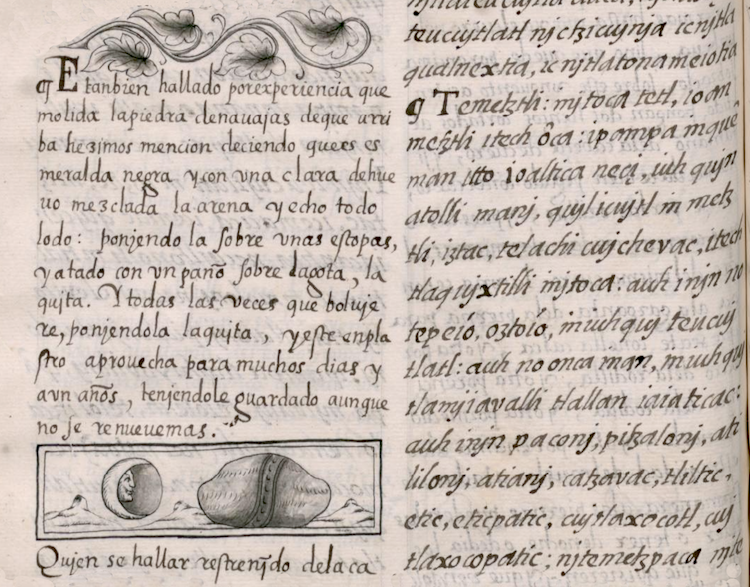temetztli (FCbk11f214v)
This is a compound glyph for temetztli (lead). The entry concerned with it appears on folio 214 verso of Book 11, “Earthly Things,” Chapter 9, “all the metals which are in the earth,” of the General History of the Things of New Spain, also known as the Florentine Codex. The compound glyph is made up of two elements that are separated from each other in a mountainous landscape, all rendered in black outlining. These elements are shaded in a range of grays. The element on the left is a crescent moon (metztli) with a human face in profile looking to the viewer's right. The moon has a semantic value, because lead was believed to be excrement from the moon (like gold is excrement from the sun). On the right is a large rock or stone (tetl) resting horizontally on the ground, a phonetic indicator for the te- beginning of the word. The tetl is drawn in a somewhat more naturalistic way than was the norm in earlier times (see below), but it retains a contrasting and curving band running through its middle. The surface of the stone has short, black vertical marks arranged in several lines across its surface that suggest a rough texture. The entire rendition of the two-element glyph betrays a certain amount of European influence.
Robert Haskett
In a Nahuatl text translated by Arthur J.O. Anderson and Charles E. Dibble, the temetztli includes the moon element because “sometimes it is seen, it appears, at night like atole resting [on the ground]. They say it is the excrement of the moon, white, but a little dark; its name is taken from this. And this is also in mines like gold. And its mother is also there, like veins zigzagging in the earth” (pg. 234). The entry also notes that the metal can be liquified, and that it is very heavy. This conceptualization of metals as excrement from celestial bodies is supported by the term for gold, teocuitlatl.
Robert Haskett
Temetztli
temetztli
Robert Haskett
1577
Robert Haskett
lead, plomo, moon, luna, rock, stone, piedra
Photograph by Robert Haskett, Museo Nacional de Antropologí e Historia, 14 February 2023.

temetz(tli), lead, plomo, https://nahuatl.wired-humanities.org/content/temetztli
te(tl), rock, stone, https://nahuatl.wired-humanities.org/content/tetl
metz(tli), moon, crescent, a month, https://nahuatl.wired-humanities.org/content/metztli
el plomo
Robert Haskett
World Digital Library, Library of Congress, https://www.loc.gov/resource/gdcwdl.wdl_10622/?sp=430
The Library of Congress is unaware of any copyright or other restrictions in the World Digital Library Collection. Absent any such restrictions, these materials are free to use and reuse. Researchers are encouraged to review the source information attached to each item. If you do publish anything from this database, please cite the Visual Lexicon of Aztec Hieroglyphs.








